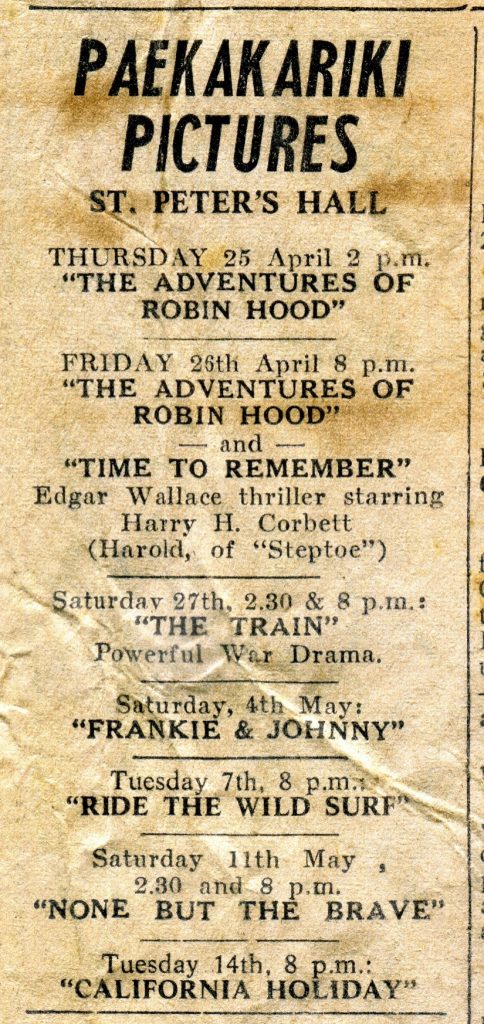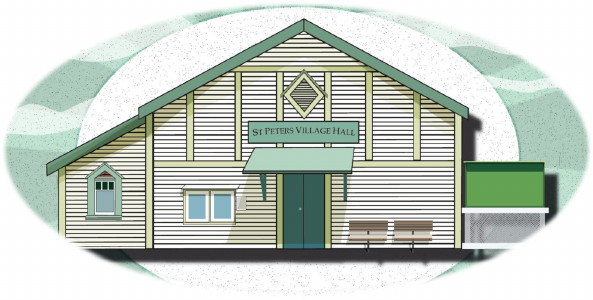PAEKĀKĀRIKI MOVIES 1930’s

By Geoff Roberts, Paekākāriki Old Boy 1930s
Movies were shown in St Peters Hall, which was located on the corner of Ames Street and the township, with St Peter’s church on the other side.
To begin with, a Mr Tootle from Seatoun east side of Wellington city had the weekly contract to show films. It was quite a performance, there being only one projector in the projector box as it was called, with a ladder up the back wall of the hall to the box.
There was no coast road to Paremata, so all manner of motorised transport came over the Paekākāriki Hill Road to our village and beyond northwards. Mr Tootle had an old Bedford car which he drove all the way from Seatoun.
On many occasions our local general storekeeper about 8.15pm would ring Pauatahanui general store to see if he had passed their store. This gave the locals at Paekākāriki picture theatre a good idea how much longer they all had to wait till he came down our side of the Hill Road to Paekākāriki.
About half past eight we heard the old Bedford car back firing as he came down behind the shelter belt of pine trees at the lower end of the Hill Road. Well, we all could not believe it, a goods train about a mile long had straddled the road crossing into Paekākāriki. By this time everybody was starting to be very tensed up to see the movies. Eventually the goods train having shunted off some wagons into one of the sidings and chugged its way out to Wellington!!
Now our picture show was really running late, I do believe it was 9 o’clock in the evening before the reels of film were going up the ladder to the projector box with many willing hands passing the reels of film up to Mr Tootle at the landing by the box. After loading the first reel into the projector ‑ British news, travel talks from the USA and Treasure Island, a real ghostly one, and Andy Clive. Well, a big cheer from all the children up front in the sixpence seats roared as Popeye the Sailor was shown on the next film reel.
Then half time. Now the older boys and girls would dash down to the general store or Holtoms tea rooms and buy icecreams and sweets to take back for the second half of the show, being the big movie ‑ Shirley Temple or perhaps Buck Jones and the Bar ‘H’ shootout with the rustlers.
The caretaker of St Peters hall would have a job controlling the children at the front seats which in those days were only forms to sit on for the children that had paid sixpence. Anyone paying one and sixpence sat in seats at the back of the forms. These seats had a good back to them, and the mums and dads brought their cushions along which made them better still.
Well, goodness me, some silly child would spill a bag of large round aniseed balls and heck, the lot would roll to the front of the bare hall floor and just under the big picture screen. Then one of the crazy kids would follow that lot up with a Phoenix soft drink bottle or perhaps a Thompson Lewis bottle. These would make a loud rolling sound and the caretaker gentleman would come from the back of the picture hall with his torch to see where the rolling bottles were. On locating them he would pick them up and put them into a bag that he carried. No doubt a lot of tuppences were made by the hall caretaker when he cleaned the hall up the next morning, as each bottle returned to the general store was tuppence gained.
However, during the winter Mr Tootle would sometimes have to stay at the boarding house by the Marine Parade as some motorists calling in at the general store would let the storekeeper know that the Hill Road was just about impassable due to snow, a southerly having blown up from the south, bringing snow to low levels along the Paekākāriki hills, while the picture show was on.
In my Mum’s and Dad’s opinion, Mr Tootle the projectionist was one of the early hardy types of people that brought shows to the settlements on the Kāpiti Coast and Mum and Dad thanked him for the great effort.
In her history section of the Hall Conservation Plan, Rozel Pharazyn quotes Rena Middleton, who remembers seeing ‘Uncle Tom’s Cabin’ as a wee tot in the early 1920s, and crying because it was so sad. Rozel notes the progress of film deliveries, quoting Ian Pedlar’s memory of ‘the boy Holtom’ in about 1930 fetching the reels of film on his motorbike from Plimmerton, after they had been shown there.
By the 1940s Rena was cashier for new owners Charlie Banks’ Gaiety Circuit. After the war Rena’s husband Dave Middleton returned from service to become manager, and Rena’s work extended to running front of house at the Mercury Theatre on the corner of McLean Street and Kapiti Road, Paraparaumu.
Dave adjusted to the progress of Cinemascope by opening out the stage curtains. St Peters was one of the first places in the region to screen this new technology, with the film Genevieve. Paekākāriki pioneered an ad hoc local solution to the new 3D, when assistant projectionist Fred Lane, a local mechanical engineer, devised a system of locking the projectors together with a shaft from both motors.
St Peter’s Hall was the only place in New Zealand where two national anthems were played before cinema screenings.
‘The reason they played both God Save the King and the Stars and Stripes,’ says cinema historian Tony Froude, ‘was because the Marine Corps was just up the road during the war and they flew in the latest Hollywood movies – before they were released in New Zealand cinemas. There were continuous showings six times a week while the Marines were here.’
 |  |
Jean Andrews recollects that during the 1940s:
“Another entertainment was the Saturday afternoon movies in St Peter’s Hall. The films became markedly better in quality and more up-to-date with the influx of the American Marines who were stationed in Paekākāriki during the Second World War, and the village livened up by the sound of their band outside the Hall before the movies.”
From The Paekākāriki Progress 1st March 1950

Harry Leslie bought the gear from Charlie banks in 1968, and he worked with Rena and Dave and then took over all together when he got his full (projectionist’s) certificate. Harry took over the contract with Selwyn Hyde of the Renown picture theatre at Shannon. Harry was a ”film nut” and an NZR accounts employee, who had run regular movie shows in other rural townships where he’d been based for some years before coming to Paekākāriki. These were the heydays of reserved Saturday night shows and matinees when theatre staff became babysitters for the parents across at the pub.
Rena’s and Dave’s daughters Margaret and Ruth Middleton entered the family business as ushers, but the 1967 introduction of ten o’clock closing of pubs and then television ended the cinema as a Saturday way of life. Harry later became the projectionist at the cinemas in Paraparaumu Beach, and then returned to run the shows at Paekākāriki for a few years from 1980. Harry’s friend and work colleague, Stan Goston joined him in the running of the St Peter’s Hall cinema when Charlie Banks pulled out of it in 1968. Stan Goston took over the administration, and from 1968 ran both the projector and the administration, until 1980, when a career promotion took him to Palmerston North. His wife Betty was the usher, and his children sold sweets to the audiences. The rents were low, but popular films and posters were costly.
Stan Goston recalls:
“When 10 o’clock closing came in we had to knock out evening shows, and T.V affected a lot of things too. In the 1970s Paekākāriki had poor television reception, but the Services Club got together and raised some money and got a translator on top of the hill at Pukerua Bay. The translator made a big difference.”
Purchases of new sets of chairs, trestles, tables, heaters etc are recorded throughout the Vestry minutes at regular intervals, though the source of the funds used is less often identified than the source of the furniture – cinema seats from Trentham hospital in 1922 and 100 chairs from the Railway refreshment rooms in the 1960s.
 | Pictures to be shown at Paekākāriki during the Month of April / May 1968 From The Kapiti Observer 11th April 1968 Alma Farrant recounts the children’s scramble for refreshments at half-time: All the kids went to the movies every Saturday afternoon and at half time they’d run up to the shop at Ocean House on the corner and buy 1 d ice blocks. Mrs. Francis had a little shop opposite the Railway Station where Industrial Optics is now, and they found you could get two ice blocks for 1 d up there so then they’d all rush up there. |
Fish and chips were banned from entry, but in the 1970s Eddie the fish man took orders before the show and delivered them to customers on the way out.
Margaret Leslie reminisces.
“The picture shows at Paekākāriki had a neighbourly intimacy. Stan Goston’s wife Betty recalls that if the weather was wet in the school holidays Stan would take leave from his job in Wellington to set up an impromptu film show for the children. She would ring around the village to let the families know. If there was a delay in the show, such as a power cut, or break in the film, she would use her cache of pennies to ring from the Post Office to let parents know their children would be late home.”
 | From Paekākāriki Newsletter November 1980 |
Film audiences fell away in the 1970s with the changes in licensing laws and the establishment of television, and the St Peter’s cinema was “just one of the six hundred small cinemas around the country that closed down, including the ones at Paraparaumu, Otaki, Fielding and Woodville”
Harry Leslie presented a Last Picture Show on Sunday, 22 June, 1997, the projectors were recovered from the Foxton Film Museum, for a Laurel and Hardy nostalgia show, where everybody stood for ‘God Save the Queen’ and jaffas were rolled down the aisles. Ocean Road resident Gilbert Haisman organised the occasion.
The headlines from Paekākāriki Xpressed newspaper December 2007 – Page 56


The Paekākāriki Community Trust have organised several Film Festivals showing “Paekākāriki On Film” a series of short documentaries about Paekākāriki and they have all been well received.
The Trust has formed its own Film Club and once again movies are being shown at the Hall. All proceeds from events go towards the St Peters Hall fund.
 |  |
Paekākāriki Xpressed Newspaper Dec 2007 / St Peters Hall Conservation Plan – May 2007
